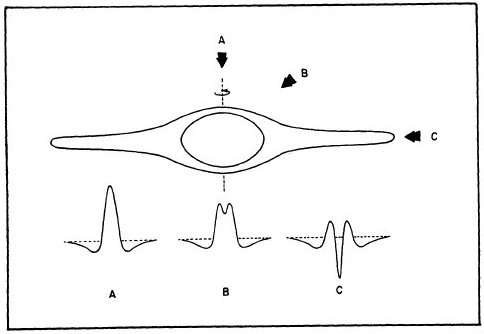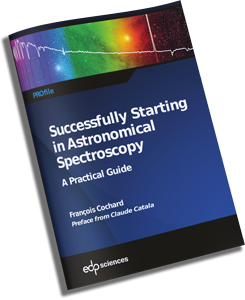Be stars
Recommended equipment : Lhires III, eShel, Lisa, Alpy
Time : one evening to a life time !
Abstract
Classical Be stars are non supergiant B-type stars that exhibit or have exhibit emission lines over the photospheric spectrum. This article review common knowledge of Be stars, a study on beta Lyrae binary Be star, what can be achieved today with commercially available high-resolution Lhires III or eShel spectrograph, the status of a Be Star Spectra pro/am database and professional/amateur astronomers collaboration.
Introduction
Be stars are hot B-type stars (effective temperature 10 000 to 30 000 K) with luminosity class III to V (ie : non supergiant stars) whose spectrum has shown at least once an emission line – usually hydrogen Balmer line. Sometimes, other emission lines are visible, for exemple neutral helium. Even when the spectrum goes back to “normal”, the star remains in the Be star class.
Some of those stars are variable with periods of several hours to several days. Pulsations have been observerved in some Be stars as well a magnetic field in one case. The phenomena behind those emission are still being actively studied and amateurs, thanks to high resolution spectrographs such as Lhires III or eShel, can now contribute to the monitoring of those stars.
After an overview of the Be stars, I focus in this article on beta Lyrae, a binary Be star which was studied for two continuous weeks, and review how amateurs can share their spectra with a Be Star Spectra database implemented with professional astronomers.

Spectrum of Delta Sco (C11, Lhires III, ST7E, 1h exposure)
Historical background
The first spectroscopic observation of Be stars has been done in 1866 by Secchi, shortly after his systematic analysis of stellar classification. He first discovered Gamma Cas, then beta Lyr. Gamma Cas is a typical Be star, the prototype for this stellar type.
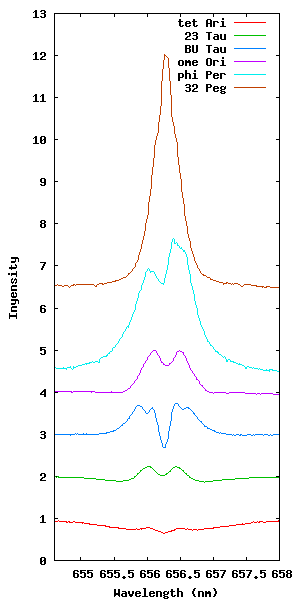
Several Be stars spectra around H-alpha
(spectrographe Lhires III, 2400tt/mm, C11/C14)
The first systematic observation program of emission lines was conducted in 1911 by Ralph Curtis at Ann Arbor in the USA. He published his first article in 1916 with Gamma Cas spectra. Like Plavec wrote in his introduction to IAU symposium 70, Curtis selected Gamma Cas because “analysing simple spectrum will help studying more complex spectra !”.
The study of Be stars really started at the beginning of 20th century with work of Paul Willard Merrill at Mount Wilson observatory, Otto Struve at Yerkes, and Dean B. McLaughlin at Michigan university. McLaughlin and Curtis published a study on bright Be stars such as Gamma Cas, beta Lyr, Phi Per, Psi Per, Pleione, Zeta Tau, Beta Mon, HR2142…
Merrill did contribute to several domain in stellar spectroscopy but started with Be star studies (Merrill 1913) and continuously published on the subject through his career.
His observation with a prism objective helped discovering hundred of new Be stars which ended in a catalog of Be stars published at Mount Wilson with Cora G. Burwell in 1933, 1943, 1949, and 1950.
In a new publication of his article, Merrill looked at a subset of Be stars (“shell stars”). He published a list in his 1949 catalog. Here is some exemple of shell stars : Gamma Cas, phi Per, Psi Per, Pleione (28 Tau), Zeta Tau, and 48 Lib.
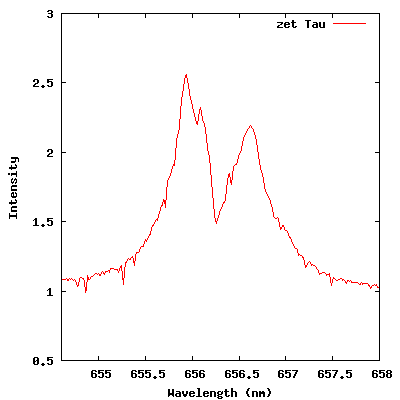
Spectrum of zeta Tau, Lhires III & C11, 50 min exposure
Struve demonstrated that Balmer emission lines are mainly visible on O5-O9 and B0-B5 stellar types, and less for B8, B9, and A0…
Merrill suggested in 1933 a large number of Be stars among B stars, around 15%-20%. This has been studied in several articles summarized by Briot & Zorec in 1981. Tomokazu Kogure and Ryuko Hirata studied in 1982 B stars from the “Bright Star Catalog” (Hoffleit 1964). They found 20% Be stars among B2 type, which is the maximum proportion in our galaxy. When you know that a third of stars you see with naked eyes are B stars… this gives you an idea of how many Be stars are brighter than 6th magnitude!
Astrophysical context
Emission lines coming from an equatorial disk is added to the photospheric absorption spectrum. Central B star emits UV (Lyman continuum) and ionizes the disk, which in turn reemits at high wavelength such as visible domain.
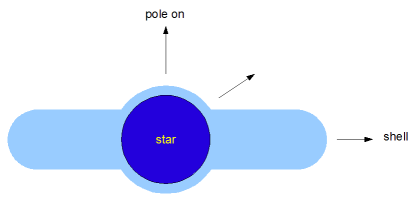
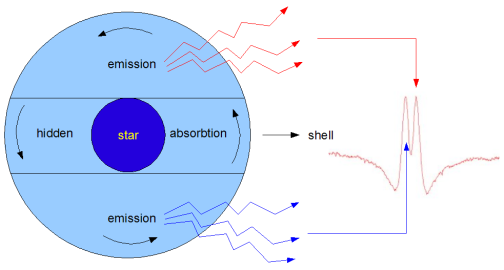
Model of a typical Be star (Kogure & Hirata, 1982)
The same Be star can have different spectrum depending how we view the disk.
Exemple of spectra of Be stars based on view angle (Slettebak 1988)
Be stars have usually a high rotational velocity (several hundreds of km/s), but still below the breakup limit. The disk is an decretion disk (material ejected by the star) and not an accretion disk (material falling toward the star) – this is not a disk coming from the star formation. Another mechanism has to be responsible for the matter to be ejected.
Be stars are close to SPB (Slow Pulsating B stars) and Beta Cephei (like BW Vul or Sigma Sco) pulsating stars in HR diagram. Non Radial Pulsations have been found in Be stars and could explain how the disk is formed (Rivinius et al. 1998). Magnetic field has also been observed in a Be star (Neiner et al. 2003) which could also explain the phenomenon.
Some other parameters could help such as high rotational velocities and presence of a companion (about a third of Be stars are binaries).
Which lines to expect on Be stars? First, hydrogene lines are the most prominient ones: H-alpha 6562.8, H-beta 4861.3, H-gamma 4340.5, H-delta 4101.7, H-epsilon 3970.1. If the star is in a Be phase, there will be emission in H-alpha. Depending on disk density, there will also be H-beta emission, possibly H-gamma. H-delta and H-epsilon are usually not seen in emission.
Neutral helium HeI can be found for exemple at 4009.3, 4026.2, 4143.7, 4387.9, 4437.5, 4471.5, 4713.1, 4921.9, 5875.6, and 6678.2. If the disk is dense, HeI emission will be seen starting from red lines going to the blue domain the denser the disk is.
Other lines can be visible in Be stars: CII (3920, 4267, 4738, 4745, 6578, 6583…), NII (3995, 4630…), OII (4119, 4367, 4415, 4642, 4649, 4662…), MgII (mainly 4481), SiIII (4552, 4568 & 4575 triplet; several lines around 3800; also at 3924, 4338, 4813, 4829 & 5740), SiII (3856, 3863, 4128, 4131, 5041, 5056, 6347, 6371), and sometimes iron FeII lines…
Beta Lyrae
Beta Lyrae is a variable star discovered by Goodricke in 1794. With a period of 12.9 days, it is the prototype of close eclipse binaries.
The system is made of a B6-B8 primary star which appears more luminous than the B0-B2e companion whose disk covers around 25% of the sky viewed from the Be star. Jet like structures have been observed, perpendicular to the orbit, with very high velocities (around 1000 km/s).
In 2005, two missions monitored this binary Be star. Groups were from CALA (Club d’Astronomie de Lyon-Ampère) and SAR (Société Astronomique de Rennes).
There are 7 binary Be stars in the Bright Star Catalog (Henrichs Huib, private communication) : Eta Ori, Beta Lyr, Omi And, VV Cep, HD203338, HD39286, and HD50820. and Beta Lyr despite the comment from Coralie Neiner that this was a very complex system to study…
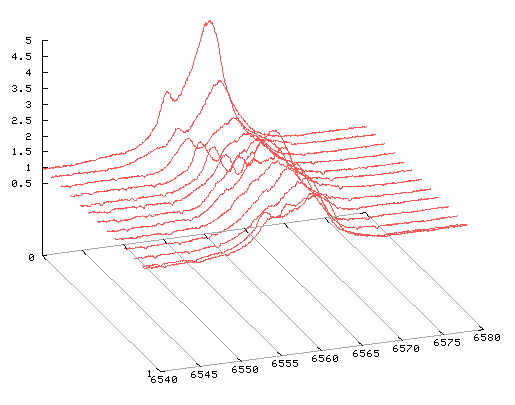
3D spectral Ha profiles sorted by binary rotation phase
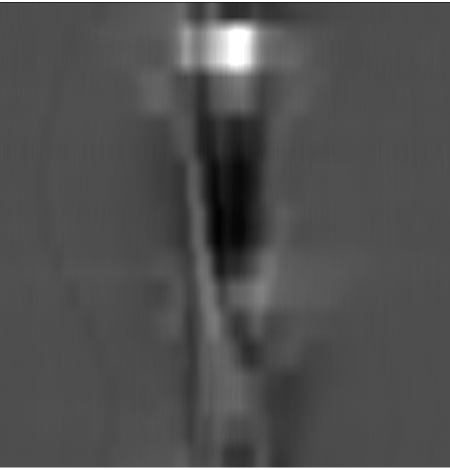
Spectrogram of Beta Lyrae (Ha) made from 32 spectra
(2h exposure each) each substracted by average spectrum
We monitored Beta Lyrae for 14 continuous days, with 132 spectra obtained. Results obtained showed how difficult it is to interpret such spectra. Next time, we will listen to professional astronomers and study simpler Be stars !
In parallel to our monitoring, another team (Christian Buil et al.) took spectra with a Lhires III of H-alpha but also sodium doublet. This was a coordinated effort between AstroQueyras and Pic du Midi T60 observatories, two structures where amateur astronomers can request mission and access to 24” telescopes. Resolutions were close for both teams.
The sodium doublet clearly shows interstellar sodium, at fixed wavelength, and sodium from the binary system swinging around due to the system rotation.
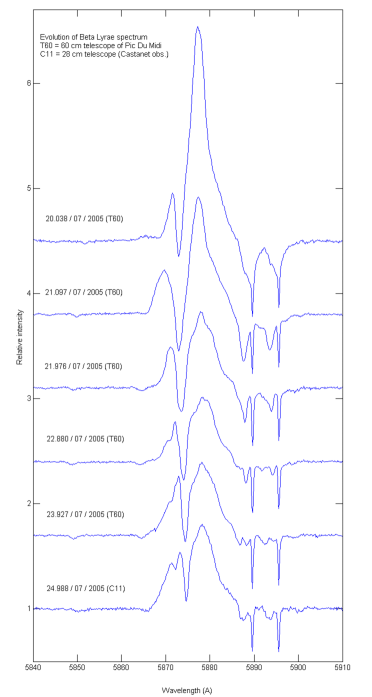
Lhires III sodium doublet monitoring (C. Buil et al.)
Multiple parameters can be measured on Be stars spectra: Intensity, V/R (when lines are double-peaked), Equivalent Width, etc…
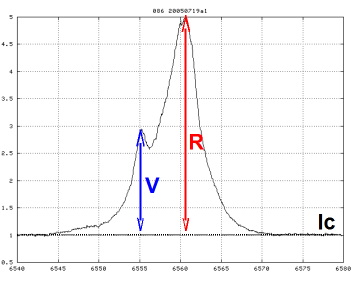
How to measure V/R ratio on a double peak spectrum
We combined in one graph measured V/R data from AstroQueyras CALA/SAR teams (24inch telescope), Christian Buil (Lhires III, 24inch and C11), François Cochard (Lhires III, C8). The graph shows that reasonable sized telescope and spectrographs such as Lhires III and now eShel can provide accurate data compared to larger telescopes and spectrographs.
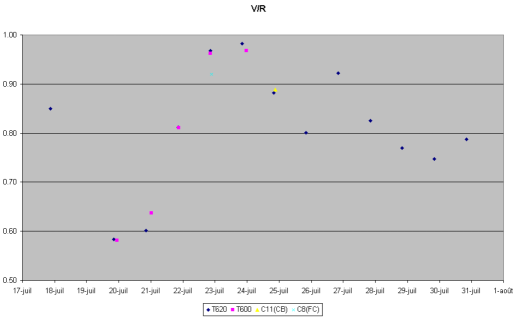
V/R measures from several sources of Beta Lyr (H-alpha)
This study, in general, provided a lot of spectra that have not yet all been processed and analysed. It also shows how complex Beta Lyrae system is : it is an eclipsing binary with an accretion disk, magnetic field, polar jet structures, mass transfer between the two stars… whose spectra are very complex to analyze and interpret.
When François Cochard and Olivier Thizy did industrialize the Lhires III and founded a company to manufacture and distribute this spectrograph, they naturally came up with the Shelyak Instruments name, Shelyak being the arabic name of beta Lyrae ! Our logo illustrate the Lyrae constellation with Beta Lyrae and its H-alpha line profile.
Spectrographs for Be stars study
In 2003, a group of professional and amateur astronomers met at Oléron for an Astrophysical School (Oleron 2003, followed by La Rochelle 2006). There, professional astronomers showed their work and highlighted where amateurs could contribute to their research. We saw there the benefit of having a high resolution (resolving power R=10 000 or above) spectrographs in several domains.
The only available commercial spectrograph at that time had only a resolving power of R=2 500 which allows survey and some monitoring but did not reveal enough line profile details.
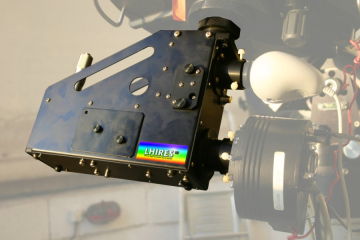
This is how the Lhires III spectrograph was designed through multiple design and manufacturing steps, originally within AUDE association then through Shelyak Instruments. Its resolving power R=17 000 makes it a perfect instrument for Be star study with relatively small amateur telescope (diameter up to 40 cm – 60 cm).
eShel, an echelle spectrograph with optical fibre fed system has then been added to Shelyak Instruments product line. It provides a broader spectral domain coverage with a resolving power of R>10 000. The 50µm fibre makes the eShel a perfect system for telescope up to 1m telescope depending on site seeing.
Those spectrographs contribute to more collaborative work. Be stars are an excellent exemple of such collaboration.
A structured Pro/Am collaboration
Following Oleron 2003, the amateur community did structure itself with the Spectro-L discussion group. It is an excellent support for alerts (outburst, special target to follow…) and general discussion about astronomical spectroscopy.
A portal has also been developped : ARAS (Astronomical Ring for Amateur Spectroscopy). It provides link to key pro/am collaboration campaigns.
Another pro/am school took place at La Rochelle in 2006 and another one will be in 2009. Spectroscopy is a technic used by more and more amateur astronomers as SAS (Society for Astronomical Science) colloquiums, VdS meeting in Heidelberg (2008) and several other meeting with AAVSO or BAA indicate. Also, a spectroscopy workshop has been organised at Observatory of Haute Provence in August: OHP 2004, OHP 2005, OHP 2007, OHP 2008, and OHP 2009.
Through 2006-2007, the GEPI team from Paris-Meudon observatory designed and implemented a Be Star Spectra (BeSS) database with help of amateur astronomers (François Cochard, Valérie Desnoux, Christian Buil, Olivier Thizy). This led to a pro/am database, with multilangage access.
URL BeSS: http://basebe.obspm.fr
We can already mention two key benefits from the BeSS database. First, a FITS format was defined for spectra which allow better exchange of data between amateurs with key data required for spectral analysis. Also, going through the full process has helped dozen of amateurs to finetune their procedure of spectra acquisition, profile extraction and calibration, etc… We strongly encourages anyone in spectroscopy to go through the process of uploading a classical Be star spectrum.
An easier access to BeSS has been developped for amateur : http://arasbeam.free.fr .Amateur can easily check which Be stars should be observed tonight based on uploaded spectra and required observation frequency.
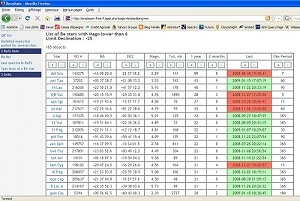
ARASBeAm Be star list ; red are urgent one to observe
Mid 2009, more than 1 500 amateur spectra have been uploaded in the database by more than 20 different users. In 2010, we reached 10 000 spectra! Amateur telescope sizes range between 120 mm and 620 mm. Spectrographs are for a vast majority Lhires III:
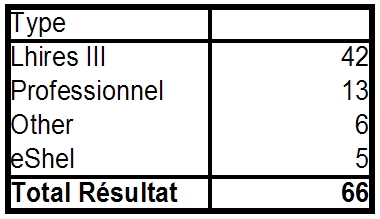
Instruments used in BeSS
VisualSpec free software has the ability to query BeSS and download spectra of a Be star for further study and analysis. BeSS is a goldmine of spectra waiting to be downloaded and studied. Some Be stars already have multiple spectra : Gamma Cas, Zeta Tau, Delta Sco… including some Be stars with specific request from professional astronomers (for exemple Upsilon Sgr, COROT targets). BeSS is waiting for everyone to take spectra of Be stars and upload the spectra! There are hundred bright Be stars well accessible with backyard telescopes and commercially available spectrographs such as Lhires III or eShel.
In August 2008, during a spectroscopy workshop at OHP, an outbusrt of QR Vul was discovered by Valérie Desnoux. Now, this star is quieter but a close monitoring would be beneficial.
Another outburst of Lambda Eri was also discovered thanks to BeSS and ARASBeAm.
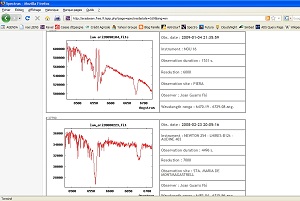
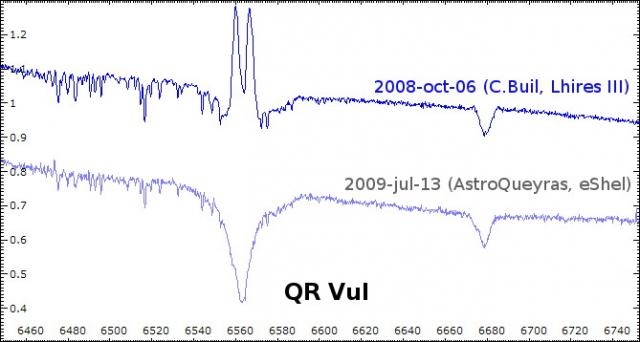
Lambda Eri and QR Vul outbursts
There are hundred Be stars you can reach with your Lhires III from your backyard. At the beginning, look for bright and easy targets (but still interesting for the professional community !) such as Gamma Cas, Zeta Tau, Delta Sco, Beta Lyr… Then look for fainter targets using BeSS and ARASBeAm.
Again, on top of BeSS, a spectro-L discussion group exist for everyone to share their results, request observations or coordinate some campaigns : http://groups.yahoo.com/group/spectro-l/
Spectroscopy workshop are also organised on a regular basis at Observatoire de Haute Provence. 40-60 people coming from several countries are coming to observe and progress together.
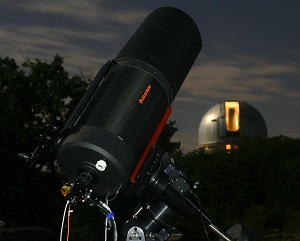
Conclusions
Be stars are great for amateurs: bright, various line profiles, variable over a wide range of periods, of interest for professional studies… Monitoring Be stars over a long period of time should help understanding their outburst mechanisms.
Pro/am collaborations and the BeSS database will also help to perform statistical research on those objects. Thanks to the broad distribution of Lhires III and now eShel spectrograph, amateurs and universities from all over the world can contribute to this work from their backyard.
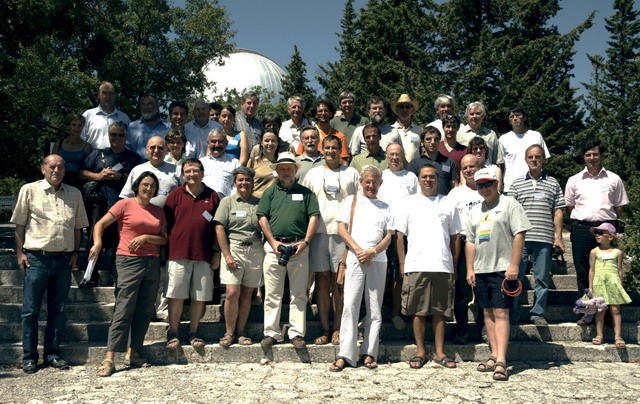
Observer group during one of OHP workshop
It is without doubt that this work can be extended to other fields of interest: RR Lyr stars, novae, Epsilon Aurigae, etc… We are obviously at the beginning of a new era for amateur astronomy.
Aknowledgements
I would like to thank Christian Buil for his continuous and enormous work on spectroscopy among others things. He would like to thank Coralie Neiner and the whole GEPI team for their support. And of course Valérie Desnoux for her great visualSpec software.
Key links :
- List Spectro-L: http://groups.yahoo.com/group/spectro-l/
- ARASBeAm: http://arasbeam.free.fr
- BeSS: http://basebe.obspm.fr
- Atlas C. Buil: http://astrosurf.com/buil/us/becat.htm
References :
- Struve, O. 1931, the Astrophysical Journal (ApJ), 74, 94-103. On the Origin of Bright Lines in Spectra of Stars of Class B. 1931ApJ….73…94S
- Slettebak, A. 1988, Publication of the Astronomical Society of the Pacific (PASP), 100, 770-784. The Be Stars. 1988PASP..100..770S
- Balona, L. A., Henrichs, H. F., et Le Contel, J. M. (eds) 1994, Pulsation, Rotation and Mass Loss in Early-Type Stars. Kluwer: Dordrecht, Germany. 1996SSRv…76..372B
- Smith M. 1999, The Be Phenomenon in Early-Type Stars: IAU Colloquium 175. 1999PASP..111.1472S
- Porter, J. M., Rivinius T., 2003. Publications of the Astronomical Society of the Pacific, 115:1153–1170. 2003PASP..115.1153P
Bibliography :
- Andrillat, Y. & Houziaux, L. 1975 cited by J. P. Swings (1976) IAU Symp. No 70, p 219
- AstroQueyras: http://www.astroqueyras.com
- Briot, D. & Zorec, J. 1981, Proc. Workshop on Pulsating B Stars, Nice Observatory, p. 109
- Buil, C. web site: http://www.astrosurf.com/buil/index.htm
- Burbidge, G. R., et Burbidge, E. M. 1953, the Astrophysical Journal (ApJ), 117, 407
- Collins, G. W. II 1987, IAU Colloquium 92, Physics of Be Stars, ed. A. Slettebak and T. P. Snow (Cambridge: Cambridge University Press), p. 3.
- Curtis, R. H. 1923, Publications of the Observatory of the University of Michigan, 3, 1
- Gerasimovic, B. P., et Curtis, R. H. 1926, Journal of the Royal Society of Canada, 20, 35
- Henize, K. G. 1976, Ap. J. Suppl. 30, 491
- Hirata, R., et Kogure, T. 1984, Bull. Astr. Soc. India (BASI), 12, 109
- Hubert 1979: atlas of Be stars
- ==>part1 (intro): https://www.shelyak-instruments.com/Web/aras/be/Atlas%20Be%28Hubert%201979%29%20-Part%201.pdf
- ==>part2 (atlas): https://www.shelyak-instruments.com/Web/aras/be/Atlas%20Be%28Hubert%201979%29-Part%202.pdf
- Jeans, J. 1928, Astronomy and Cosmogony, p. 257.
- Kaler, J. B. 2002, Stars and their spectra, Cambridge University Press (reprint)
- Kitchin, C. R. 1995, Optical Astronomical Spectroscopy, Institute of Physics Publishing
- Kogure, T., et Hirata, R. 1982, Bull. Astr. Soc. India (BASI), 10, 281
- Massa, D. 1975, Publication of the Astronomical Society of the Pacific (PASP), 87, 777
- Meadows, A. J. 1960, Astronomical Journal, 65, 335
- Merrill, P. W. 1913, Lick Observatory Bulletin, 7, 162
- Merril, P. W. 1933, Publication of the Astronomical Society of the Pacific (PASP), 45, 198
- Merrill, P. W. 1952, the Astrophysical Journal (ApJ), 115, 145. Etude de 28 Tauri (Pleione).
- Merrill, P. W. 1953, the Astrophysical Journal (ApJ), 117, 7. Etude de 48 Libra.
- Merrill, P. W., et Burwell, C. G. 1933, the Astrophysical Journal (ApJ), 78, 87
- __________. 1943, the Astrophysical Journal (ApJ), 98, 153
- __________. 1949, the Astrophysical Journal (ApJ), 110, 387
- __________. 1950, the Astrophysical Journal (ApJ), 112, 72
- Percy et al. 1996, Journal of American Association of Variable Star Observers (JAAVSO), 25, 14
- Pollmann E., 2005. Publ. Astron. Inst. ASCR 93, 14-20
- Rivinius et al. 1998, Astron. Astrophys. 333, 125–140
- Rivinius et al. 1998, Astron. Astrophys. 336, 177–190
- Slettebak, A. 1979, Space Science Review (SSRv), 23, 541
- Struve, O. 1930, the Astrophysical Journal (ApJ), 72, 1-18. On the Axial Rotation of Stars.
- Struve, O. 1942, the Astrophysical Journal (ApJ), 95, 134.
- Struve, O. 1943, the Astrophysical Journal (ApJ), 98, 98.
- Struve, O., et Wurm, K. 1938, the Astrophysical Journal (ApJ), 88, 84
28 Tau spectrum
Note : This article has been published in similar form in french in SAF Astronomie magazine and also in english during SAS symposium in 2008.

